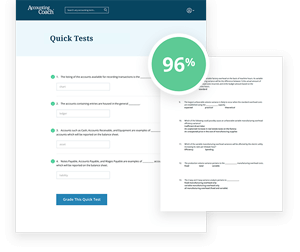1.
Another name for the balance sheet is
Statement Of Financial Position
2.
The balance sheet heading will specify a
3.
Which of the following is a category, classification, or element of the balance sheet?
4.
Which of the following is an asset account?
5.
Which of the following is a contra account?
6.
What is the normal balance for an asset account?
7.
What is the normal balance for liability accounts?
8.
What is the normal balance for stockholders' equity and owner's equity accounts?
9.
What is the normal balance for contra asset accounts?
10.
ABC Co. received $1,000 in December for services it will perform in the following month. ABC uses the accrual basis of accounting. In December ABC debited Cash for $1,000. What will be the other account involved in the December accounting entry prepared by ABC (and what type of account is it)?
Accounts Receivable (asset)
Service Revenues (revenue)
Unearned Revenues (liability)
11.
ABC Co. performed services for Client Kay in December and billed Kay $4,000 with terms of net 30 days. ABC follows the accrual basis of accounting. In January ABC received the $4,000 from Kay. In January ABC will debit Cash, since cash was received. What account should ABC credit in the January entry?
12.
ABC Co. follows the accrual basis of accounting and performs a service on account (on credit) in December. The service was billed at the agreed upon amount of $3,500. ABC Co. debited Accounts Receivable for $3,500 and credited Service Revenue for $3,500. The effect of this entry on the balance sheet of ABC is to increase assets by $3,500 and to .
Decrease Assets By $3,500
Increase Owner's (stockholders') Equity By $3,500
13.
Which of the following is not a current asset?
14.
Which of the following is normally a current liability?
Note Payable Due In Two Years
15.
When an owner draws $5,000 from a sole proprietorship or when a corporation declares and pays a $5,000 dividend, the asset Cash decreases by $5,000. What is the other effect on the balance sheet?
Owner's/stockholders' Equity Decreases
16.
ABC Co. incurs cleanup expense of $500 on December 30. The supplier's invoice states that the $500 is due by January 10 and ABC will pay the invoice on January 9. ABC follows the accrual basis of accounting and its accounting year ends on December 31. What is the effect of the cleanup service on the December balance sheet of ABC?
No Effect On Owner's Equity
17.
Deferred credits will appear on the balance sheet under which heading/classification?
Owner's/stockholders' Equity
18.
Notes Payable could not appear as a line on the balance sheet in which classification?
19.
On December 1, ABC Co. hired Juanita Perez to begin working on January 2 at a monthly salary of $4,000. ABC's balance sheet of December 31 will show a liability of what amount?
20.
ABC Co. has current assets of $50,000 and total assets of $150,000. ABC has current liabilities of $30,000 and total liabilities of $80,000. What is the amount of ABC's owner's equity?
21.
The amount reported on the balance sheet for Property, Plant and Equipment is the company's estimate of the fair market value as of the balance sheet date.
22.
The total amount reported for stockholders' equity is the approximate fair value or net worth of the corporation as of the balance sheet date.
23.
The book value of a corporation is the total amount of stockholders' equity reported on the balance sheet.
24.
The third line of the balance sheet heading for the end of the year should begin with "For the Year Ended".
